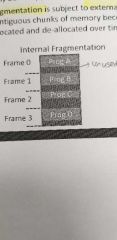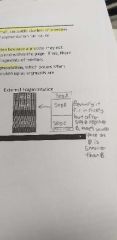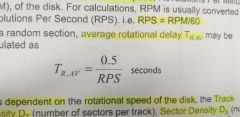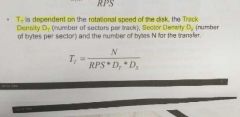![]()
![]()
![]()
Use LEFT and RIGHT arrow keys to navigate between flashcards;
Use UP and DOWN arrow keys to flip the card;
H to show hint;
A reads text to speech;
54 Cards in this Set
- Front
- Back
|
Advantages of Direct Mapped Cache |
-Simple to implement -Easy and fast to find item |
|
|
Disadvantages of Direct Mapped Cache |
-very prone to cache thrashing -lowest hit rate |
|
|
Advantages of N-way set associative cache |
-less cache thrashing -higher hit rate |
|
|
Disadvantage of N-way set associative cache |
-more complex design -longer search time |
|
|
What is cache thrashing |
Same block being replaced frequently -leads to lower hit rate -cache memory not fully utilised |
|
|
What is locality of space |
Code/data stored close together will likely to be accessed together |
|
|
2 tasks that cache need to do |
Storage Retrieval |
|
|
Locality of time |
Recently executed code/data will more likely to be executed again |
|
|
Disadvantage of LRU |
LRU needs to maintain access history for each block, slows down cache |
|
|
Benefit of random replacement policy |
It never thrashes |
|
|
What are dirty blocks |
Blocks that have been updated while they are in the cache |
|
|
What is write through |
Updates cache and main memory simultaneously on every write |
|
|
What write back |
Updates memory only when the block is selected for replacement |
|
|
Advantage of write through |
No cache coherency issue |
|
|
Disadvantage of write through |
More traffic on system bus |
|
|
What is cache coherency |
Content in cache is different from the equivalent address in the main memory Happens when CPU writes to cache but not to main memory |
|
|
Effective Access Time (EAT) formula |
EAT = H x AccessC + (1-H)x(AccessC + AccessMM) |
|
|
Order of CPU Memory Access |
CPU -> Cache -> Main Memory -> Disk |
|
|
Purpose of cache |
Store recently used data near to CPU so that access can be faster and improve system performance |
|
|
What does virtual memory do |
Extend address space |
|
|
Disadvantages of having virtual memory |
- more virtual memory means longer access time (copy to main memory may be needed) |
|
|
What is segmentation |
Dividing virtual address space into variable length segments |
|
|
What is memory fragmentation |
Occurs when small unusable clusters of memory addresses are created |
|
|
How is memory fragmentation caused |
By paging and segmentation |
|
|
Paging causes internal or external fragmentation |

Internal |
|
|
Segmentation causes internal or external fragmentation |

External |
|
|
Advantages of virtual memory |
- Allows system to run programs that are bigger than main memory - Frees application from having to manage a shared memory space in physical memory -Virtual address space can be seen as contiguous but it is actually spread across fragmented blocks in physical memory |
|
|
What is Translated Lookup Buffer (TLB)? |
It is a cache data table containing the recent page lookup values |
|
|
How is data stored in HDD |
Data is stored on the concentric rings called tracks. |
|
|
Why are there gaps between tracks |
To minimise interference from adjacent tracks |
|
|
What does the stored data of HDD consist of |
Header, data, trailer |
|
|
HDD - what is seek time |
Time taken for head to move to correct track |
|
|
HDD- what is rotational delay |
Time taken for the disk to rotate until the head reaches the starting position of the sector |
|
|
Hdd- what is access time |
Time from request to the time the head is in position |
|
|
Hdd - What is transfer time |
Time required to transfer the required data after head is positioned |
|
|
Formula for average rotational delay |

|
|
|
Hdd- formula for transfer time |

|
|
|
What are the 2 addressing scheme for HDD |
- Cylinder Head Sector (CHS) - Logical Block Addressing (LBA) |
|
|
Disadvantage of CHS |
Cannot handle large address ranges |
|
|
Advantage of LBA |
Simple linear addressing |
|
|
2 techniques to extend the life of SSD |
- wear levelling - use external RAM as buffer |
|
|
What is wear levelling |
Distributing data and erase/write cycle evenly over the entire disk |
|
|
How does external RAM help to extend life of SSD |
Minimise the number of writes to FLASH in SSD |
|
|
Formula for chance of failure |

|
|
|
Problems in HDD |
- access times for moving the heads lowers the transfer rate - mechanical device, suffer from crash |
|
|
Purpose of RAID |
Improve reliability and performance |
|
|
Explain RAID level 0 |
No redundancy Best performance No fault tolerance Needs minimum of 2 disks Data striped as blocks across all disks |
|
|
Explain RAID level 1 |
-Mirrored disk -100% redundancy -Data is written to both disks -Write throughput is slower because every drive must be updated -need minimum of 2 disks |
|
|
Advantages of RAID Level 1 |
- Easy to recover data - Faster read operation |
|
|
Disadvantages of RAID level 1 |
Write throughput is slower Expensive |
|
|
Explain RAID Level 5 |
- Block level striping with single distributed parity - Data on single failed drive can be reconstructed from surviving data and parity info - commonly used in network server |
|
|
Explain RAID level 6 |
- May recover from multiple disk failures - uses block level striping with double distributed parity |
|
|
Advantage and disadvantage of RAID level 6 |
Advantage: high data availability Disadvantage: significant write penalty |
|
|
Explain RAID level 10 |
Combines protection of RAID 1 with performance of RAID 0 More expensive |

